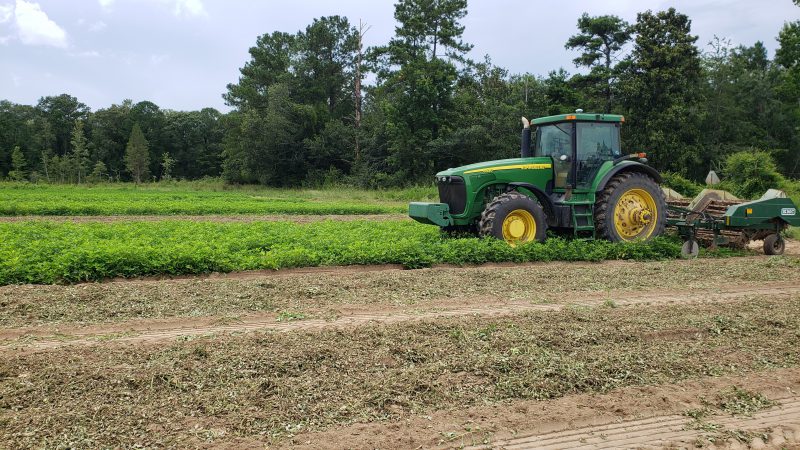
Green/immature peanuts for boiling are being harvested in Washington County. While the growing season for these peanuts is a bit shorter than it is for dry peanuts, seeing a digger in the field is a strong reminder that this year’s crop is well on it’s way. It’s time to start keeping an eye on crop maturity and thinking about optimizing harvest timing. Credit: Mark Mauldin, UF/IFAS
For a growing plant, not all calendar days are created equally, temperature and available moister can impact a plant’s ability to meet its maximum potential for growth/development on any specific day – in short, plants are more productive some days than others. Adjusted Growing Degree Days (aGDDs) are a unit of measure which are used to track crop progress. aGDDs account for temperature and available moisture, making them a more reliable tool for predicting crop maturity than the calendar.
Medium maturity runner type peanuts (like Georgia 06G) will reach physiological maturity after the accumulation of approximately 2500 aGDDs. Later maturing varieties will need to accumulate slightly more aGDDs before they reach maturity. The aGDD Tracker below shows the number of adjusted Growing Degree Days (aGDDs) accumulated by 72 fictional fields (8 locations x 9 planting dates) as of 8/13/25.
The locations shown on the aGDD Tracker were selected to correspond to FAWN weather stations. Temperature data from each station was used to calculate the number of Growing Degree Days possible for each location. Rainfall and irrigation data in combination with the water holding capacity of common soil types for the areas (Jay – sandy loam, Marianna – loamy sand, Marianna Irrigated – sand, Monticello – loamy sand, Live Oak and Bronson – sand) was used to predict available moisture and adjust the number of growing degree days accordingly, resulting in the final aGDD value shown.
Use the aGDD Tracker to approximate how your fields are progressing by following the fields on the Tracker that are the most similar to yours in terms of planting date, location and irrigation status. The aGDD Tracker is intended only to help growers have a better frame of reference for when it is time to sample and pod-blast a gvien field. If the aGDD value shown for your field is black (under 2300), it’s probably not time to dig. If it’s yellow (between 2300 and 2500), you’re getting close, so it’s time to pull samples and pod-blast to fine tune your harvest timing. Unless you are growing a late maturity variety, Orange (2500+) means it’s almost certainly time to harvest, but pod-blasting is always the best way to know for sure.
For more precise tracking of your fields, go to PeanutFARM.org and set up your fields in the system. You will be able to enter field specific rainfall/irrigation data and soil type. Temperature data will come from the closest FAWN weather station. If you are interested in setting up your own fields on PeanutFARM.org don’t hesitate to contact me for assistance.
–
aGDD Tracker for the Florida Peanut Producing Region – 8/13/25 edition
The aGDD Tracker is compiled from data generated by PeanutFARM.org. The dark blue bars, in the cells behind the aGDD values, indicate progress towards 2500 aGDDs. The bar extends to the right as aGDDs are accumulated. The entire cell will be dark blue when a field has accumulated 2500 aGDDs. It is recommended that fields be sampled, and exact days-to-harvest be determined via pod-blasting once a field reaches 2300 aGDDs.
An updated aGDD Tracker will be posted on Panhandleag.org at least every other week through peanut harvest season in NW Florida.
–
Using some simple math to predict number of calendar days until harvest (based on the rate of aGDD accumulation thus far this season), it appears that almost all fields are currently tracking ahead of the calendar. That said, the growing season is not over, far from it, for later planted fields. Growing conditions can change rapidly as we move into the fall. Be sure to keep an eye on the future additions of the aGDD Tracker and sample/pod-blast at the appropriate time to get the information you need to optimize your harvest timing.
- Peanut Maturity Update – 10/9/25 - October 10, 2025
- Fall Can be a Great Time for Vegetation Management - October 3, 2025
- Peanut Maturity Update – 9/25/25 Edition - September 26, 2025
